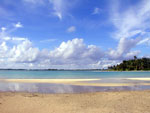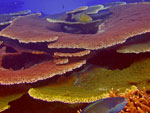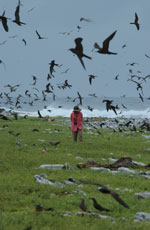
Announcement of Phoenix Islands Protected Area by Hon. Martin Puta Tofinga, Minister of Environment Lands and Agricultural Development
REPUBLIC OF KIRIBATI AT THE HIGH LEVEL EVENT – COP8 "ISLANDS, MARINE BIODIVERSITY AND LIVELIHOODS: A GLOBAL PARTNERSHIP"
(28 March 2006, Curitiba, Brazil)
Download PDF: Announcement of Phoenix Islands Protected Area
Thank you your Excellency Mr. President, and the other co-hosts of tonight's wonderful event.
It is a great pleasure for Kiribati to be here tonight for this occasion to highlight the importance of Islands and Pacific Biodiversity. This is a vitally important topic to us, as well as all Pacific Island countries, because of our ancient connection to the sea and all that the sea provides.
Kiribati, the largest atoll nation in the world, is blessed with vast ocean resources stretching from the Gilbert Islands to the Phoenix Islands and on to the Line Islands, with a total EEZ of 3.5 million square kilometers. Because our nation depends on the ocean, both spiritually and financially, and because we are committed to the goals of the CBD, we have an announcement to make.
Tonight the Government of Kiribati is declaring the Phoenix Islands Protected area. This region has eight atolls and two submerged reef systems. The nearly uninhabited Phoenix Islands Protected Area is the largest marine protected area in the Pacific Islands at 184,700 square kilometers, twice the size of Portugal, and the third largest marine protected area in the world. It contains a near pristine coral archipelago with abundant marine and terrestrial biodiversity, including native medicinal plants that are disappearing from our inhabited islands, and is the first marine protected area in the region with deep-sea habitat, including seamounts. The Government of Kiribati is also considering listing these islands as a World Heritage Site
The work leading to this announcement began six years ago, but we have recently completed several milestones that make this declaration possible and appropriate for the CBD COP8 venue. In collaboration with the New England Aquarium and other partners we have conducted a series of scientific research expeditions to the region documenting the terrestrial and shallow water marine biodiversity, and discovering new species of fish and coral. The results of this work will soon be published in the scientific journal ATOLL RESEARCH BULLETIN. This scientific information is guiding our conservation plan. There will also be a deep sea research trip in the next year to further expand our knowledge of the region. We have also developed and signed a Memorandum of Understanding with the New England Aquarium and Conservation International that details the development of a management plan and a long-term financing mechanism.
At the heart of this program is the desire of Kiribati to promote both land and marine biodiversity protection and the long-term interests of I-Kiribati people. We believe this is possible because of a financially sustainable plan for this protected area that incorporates a diversity of funding sources and mechanisms including an endowment system that will compensate Kiribati for lost fishing license revenues as well as for management costs.
Since the beginning of human settlement of the Pacific Islands region, the Phoenix Island's coral reefs, terrestrial habitats and bird populations represent a marine wilderness area that has undergone very limited human exploitation due to their extreme remoteness. With recent advances and pressures in the fishing industry and impacts of global climate change, isolation can no longer be relied on to conserve the biodiversity of these atolls.
The Government of Kiribati, in partnership with the New England Aquarium, Conservation International, and other partners and donors are working together to provide what we believe is an innovative and sustainable model for large scale conservation in the region. We welcome new partners and collaborators on this exciting and vitally important endeavor.
Thank you and good evening.

NATIONAL
GEOGRAPHIC MAGAZINE
Features NAI'A's Phoenix Islands Expedition
"On the healthy reefs of the Phoenix Islands, scientists find new species and clues to preserving paradise..." Explore along with us:
Follow our Dispatches from Sea



